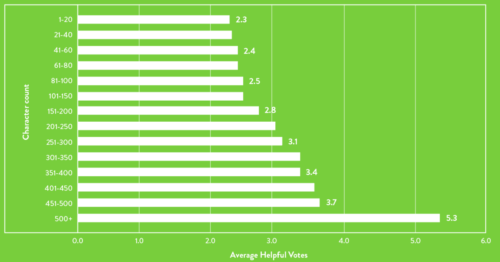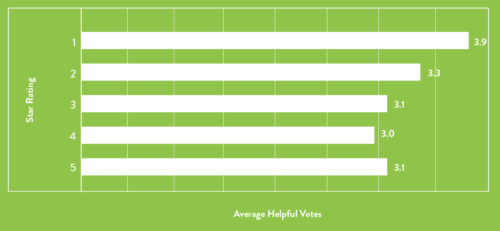An Analysis of 7.8 Million Reviews in the PowerReviews Open Network
There was once a time (in the not so distant past) when the idea of asking for feedback from customers — then displaying that feedback for the world to see — was a pretty radical concept. But now, the importance of ratings and reviews is largely understood by brands and retailers as a key part of the consumer’s purchase journey. In fact, nearly all consumers consult customer reviews, and 86% consider them an essential resource when making a purchase decision.
Clearly, consumers find reviews helpful when identifying the products that best fit their needs. But not all reviews are created equal. While one review may be full of great insights, another may fall short. At PowerReviews, we allow consumers to give individual reviews “helpful” or “not helpful” votes to indicate how useful a given review was during the shopping experience.

So what makes one review more helpful than another? To shed light on this question, we analyzed 7.8 million reviews from the past year in the PowerReviews Open Network to determine the common features of reviews that have been voted by consumers as helpful. We explored the impact of various review characteristics — including review length, sentiment and recency — as well as the types of products that are most likely to have reviews with helpful votes.
During the most recent PowerReviews webinar, I shared the results of this analysis. Read on for a summary of three key findings that I shared during the webinar, as well as some recommendations for brands and retailers to start generating and displaying the content that’s most helpful to consumers.
Longer Reviews Aid Consumers
We found that review length is the characteristic most correlated with helpful votes. The longer the character count of a review, the greater its average number of helpful votes. While a review that’s under 20 characters has an average of 2.3 helpful votes, a review with 500 or more characters has an average of 5.3 helpful votes.
Longer Reviews are More Helpful

Recommendation for Brands and Retailers: Longer reviews provide greater detail, which make them more helpful to future shoppers. One way for brands and retailers to generate longer (and likely, more helpful) reviews is to tie in review generation to an existing rewards program and award points for longer reviews, regardless of the star rating. Then, once a consumer accrues a set number of points, they receive some type of award, such as a coupon or a code for free shipping.
One-Star Reviews Have the Most Helpful Votes
Our analysis also found that one-star reviews, on average, generate more “helpful” votes than any other star rating. Why? Because—in addition to adding a level of authenticity to your review content, negative reviews steer consumers towards products that best fit their needs.
Consumers want to hear the worst thing someone has to say about a product. In fact, 82% of consumers seek out negative reviews. Reading negative reviews helps a consumer determine if negative elements are relevant to their needs.
For example, let’s say you’re a brand that sells running shoes. One particular style of shoe has a one-star rating, with a review that notes that the shoe doesn’t work well for trail running. A future shopper finds this review helpful because she does all of her running on a treadmill. The previous consumer’s comment about trail running is irrelevant to her.
Average Helpful Votes By Star Rating

Recommendation for Brands and Retailers: Though you certainly don’t want to aim for negative reviews, this content is a helpful tool that allows consumers to identify the products that best fit their needs. In addition, negative reviews provide a level of authenticity to your content. Previous research found that nearly half (44%) of Generation Z shoppers wouldn’t trust a product’s reviews if there were no negative reviews present. And finally, negative reviews allow you to identify insights to improve future iterations of your products, as well as the overall customer experience.
Visual Content Boosts Helpfulness
A growing number of consumers are seeking out reviews that include user-submitted visual content, such as photos and videos. In fact, recent research on the role of visual content found that 88% of consumers look for visual content—such as photos and videos—submitted by other consumers prior to making a purchase. And a product experiences a 69% conversion rate lift, on average, when that product adds at least one user-generated image.
Since consumers are actively seeking out this content, it makes sense that reviews with helpful votes include more photos and videos than those without. Reviews with helpful votes have 16% more videos and 13.8% more photos than those without visual content.
Recommendation for Brands and Retailers: More and more consumers depend on user-generated visual content to inform their purchases. Ensure you’re making it easy for your shoppers to submit photos and videos as part of their reviews. This visual content makes product reviews even more helpful to future shoppers.
Curious what else I covered during this webinar? Watch the on-demand session now!




